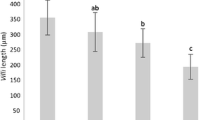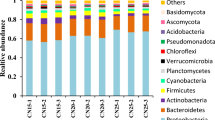Abstract
Increasing levels of a mixture of Ulva spp. produced in an integrated multi-trophic aquaculture (IMTA) system were evaluated in Nile tilapia juveniles for partial replacement of dietary fish meal. A control diet (CTRL) was compared with three experimental diets containing 10 % (U10), 15 % (U15), and 20 % (U20) of Ulva spp. meal. Triplicate groups of fish (13 g initial body weight) were fed each diet for 63 days at 26 °C. Nutrient apparent digestibility coefficients and nitrogen retention efficiency did not vary significantly among diets. By the end of the trial, all groups of fish more than tripled their initial body weight. Specific growth rate and final body weight of U10 diet were similar to CTRL and significantly higher than U15 and U20 diets. Increasing Ulva dietary incorporation levels significantly increased feed conversion ratio (FCR), from 1.0 (CTRL) to 1.4 (U20). Fish fed with U10 diet had the highest protein efficiency ratio and nitrogen retention efficiency allowing this fish to growth and reach a final body weight similar to the CTRL group. Protein content was highest in fish fed with the CTRL diet, whereas the highest lipid content was observed in fish fed with U20 diet. The results show that the incorporation of IMTA-produced Ulva meal in Nile tilapia diets is possible up to 10 % without compromising growth performance, protein utilization, and protein retention of juveniles. The high capacity of Nile tilapia to digest all experimental diets suggests that Ulva meal is a practical partial replacement for fish meal in Nile tilapia diets.
Similar content being viewed by others
References
Abreu MH, Varela DA, Henriquez L, Villarroel A, Yarish C, Sousa-Pinto I, Buschmann AH (2009) Traditional vs. integrated multi-trophic aquaculture of Gracilaria chilensis C. J. Bird, J. McLachlan & E. C. Oliveira: productivity and physiological performance. Aquaculture 293:211–220
Abreu MH, Pereira R, Yarish C, Buschmann AH, Sousa-Pinto I (2011) IMTA with Gracilaria vermiculophylla: productivity and nutrient removal performance of the seaweed in a land-based pilot scale system. Aquaculture 312:77–87
Al Hafedh YS (1999) Effects of dietary protein on growth and body composition of Nile tilapia, Oreochromis niloticus L. Aquac Res 30:385–393
AOAC (2006) Official methods of analysis of AOAC International. AOAC International, Gaithersburg
Azaza MS, Mensi F, Ksouri J, Dhraief MN, Brini B, Abdelmouleh A, Kraiem MM (2008) Growth of Nile tilapia (Oreochromis niloticus L.) fed with diets containing graded levels of green algae ulva meal (Ulva rigida) reared in geothermal waters of southern Tunisia. J Appl Ichthyol 24:202–207
Bolin DW, King RP, Klosterman EW (1952) A simplified method for the determination of chromic oxide (Cr2O3) when used as an index substance. Science 116:634–635
Buschmann AH, Troell M, Kautsky N, Kautsky L (1996) Integrated tank cultivation of salmonids and Gracilaria chilensis (Gracilariales, Rhodophyta). Hydrobiologia 327:75–82
Buschmann AH, Troell M, Kautsky N (2001) Integrated algal farming: a review. Cah Biol Mar 42:83–90
Chopin T, Yarish C, Wilkes R, Belyea E, Lu S, Mathieson A (1999) Developing Porphyra/salmon integrated aquaculture for bioremediation and diversification of the aquaculture industry. J Appl Phycol 11:463–472
Chopin T, Buschmann AH, Halling C, Troell M, Kautsky N, Neori A, Kraemer GP, Zertuche-Gonzalez JA, Yarish C, Neefus C (2001) Integrating seaweeds into marine aquaculture systems: a key toward sustainability. J Phycol 37:975–986
Chopin T, Robinson SMC, Troell M, Neori A, Buschmann AH, Fang J (2008) Multitrophic integration for sustainable marine aquaculture. In: Jørgensen S, Fath B (eds) Encyclopedia of ecology. Ecological engineering, vol 3. Elsevier, Oxford, pp 2463–2475
Choubert G, Delanoue J, Luquet P (1982) Digestibility in fish—improved device for the automatic collection of feces. Aquaculture 29:185–189
Davies SJ, Brown MT, Camilleri M (1997) Preliminary assessment of the seaweed Porphyra purpurea in artificial diets for thick-lipped grey mullet (Chelon labrosus). Aquaculture 152:249–258
Davies SJ, Abdel-Warith AA, Gouveia A (2011) Digestibility characteristics of selected feed ingredients for developing bespoke diets for Nile tilapia culture in Europe and North America. J World Aquacult Soc 42:388–398
Dias J, Alvarez MJ, Arzel J, Corraze G, Diez A, Bautista JM, Kaushik SJ (2005) Dietary protein source affects lipid metabolism in the European seabass (Dicentrarchus labrax). Comp Biochem Physiol A 142:19–31
Diler I, Tekinay AA, Güroy D, Güroy BK, Soyuturk M (2007) Effects of Ulva rigida on the growth, feed intake and body composition of common carp, Cyprinus carpio L. J Biol Sci 7:305–308
El-Sayed AFM (1999) Alternative dietary protein sources for farmed tilapia, Oreochromis spp. Aquaculture 179:149–168
El-Sayed AFM, Tacon AGJ (1997) Fishmeal replacers for tilapia: a review. Cah Options Mediterr 22:205–224
Ergün S, Soyuturk M, Güroy BK, Güroy D, Merrifield D (2009) Influence of Ulva meal on growth, feed utilization, and body composition of juvenile Nile tilapia (Oreochromis niloticus) at two levels of dietary lipid. Aquac Int 17:355–361
Fagbenro OA (1998) Apparent digestibility of various legume seed meals in Nile tilapia diets. Aquac Int 6:83–87
FAO (2012) The state of world fisheries and aquaculture 2012. FAO, Rome
Fleurence J (1999) Seaweed proteins: biochemical, nutritional aspects and potential uses. Trends Food Sci Technol 10:25–28
Fournier V, Huelvan C, Desbruyeres E (2004) Incorporation of a mixture of plant feedstuffs as substitute for fish meal in diets of juvenile turbot (Psetta maxima). Aquaculture 236:451–465
Francis G, Makkar HPS, Becker K (2001) Antinutritional factors present in plant-derived alternate fish feed ingredients and their effects in fish. Aquaculture 199:197–227
Goda A, Wafa ME, El-Haroun ER, Chowdhury MAK (2007) Growth performance and feed utilization of Nile tilapia Oreochromis niloticus (Linnaeus, 1758) and tilapia galilae Sarotherodon galilaeus (Linnaeus, 1758) fingerlings fed plant protein-based diets. Aquac Res 38:827–837
Güroy BK, Cirik S, Güroy D, Sanver F, Tekinay AA (2007) Effects of Ulva rigida and Cystoseira barbata meals as a feed additive on growth performance, feed utilization, and body composition of Nile tilapia, Oreochromis niloticus. Turk J Vet Anim Sci 31:91–97
Güroy D, Güroy BK, Merrifield DL, Ergün S, Tekinay AA, Yigit M (2011) Effect of dietary Ulva and Spirulina on weight loss and body composition of rainbow trout, Oncorhynchus mykiss (Walbaum), during a starvation period. J Anim Physiol Anim Nutr 95:320–327
Hardy RW, Tacon AGJ (2002) Fish meal: historical uses, production trends and future outlook for sustainable supplies. In: Stickney RR, McVey JP (eds) Responsible marine aquaculture. Oxford University Press, New York, pp 311–326
Holdt SL, Kraan S (2011) Bioactive compounds in seaweed: functional food applications and legislation. J Appl Phycol 23:543–597
Jimenez del Río M, Ramazanov Z, García-Reina G (1996) Ulva rigida (Ulvales, Chlorophyta) tank culture as biofilters for dissolved inorganic nitrogen from fishpond effluents. Hydrobiologia 326/327:61–67
Köprücü K, Özdemir Y (2005) Apparent digestibility of selected feed ingredients for Nile tilapia (Oreochromis niloticus). Aquaculture 250:308–316
Krom MD, Neori A (1989) A total nutrient budget for an experimental intensive fishpond with circularly moving seawater. Aquaculture 83:345–358
Lüning K, Pang SJ (2003) Mass cultivation of seaweeds: current aspects and approaches. J Appl Phycol 15:115–119
Mata L, Santos R (2003) Cultivation of Ulva rotundata (Ulvales, Chlorophyta) in raceways using semi-intensive fishpond effluents: yield and biofiltration. In: Chapman ARO, Anderson RJ, Vreeland V, Davison IR (eds) Proceedings of the 17th international seaweed symposium, Cape Town 2001. Oxford University Press, New York, pp 237–242
Mata L, Schuenhoff A, Santos R (2010) A direct comparison of the performance of the seaweed biofilters, Asparagopsis armata and Ulva rigida. J Appl Phycol 22:639–644
Matos J, Costa S, Rodrigues A, Pereira R, Pinto IS (2006) Experimental integrated aquaculture of fish and red seaweeds in Northern Portugal. Aquaculture 252:31–42
Maynard LA, Loosli JK, Hintz HF, Warner RG (1979) Animal nutrition. McGraw-Hill, New York
Msuya FE, Neori A (2002) Ulva reticulata and Gracilaria crassa: macroalgae that can biofilter effluent from tidal fishponds in Tanzania. West Indian Ocean J Mar Sci 1:117–126
Murata M, Nakazoe J (2001) Production and use of marine algae in Japan. Jpn Agric Res Q 35:281–290
Mustafa MG, Wakamatsu S, Takeda TA, Umino T, Nakagawa H (1995) Effects of algae meal as feed additive on growth, feed efficiency, and body composition in red sea bream. Fish Sci 61:25–28
Neori A, Ragg NLC, Shpigel M (1998) The integrated culture of seaweed, abalone, fish and clams in modular intensive land-based systems: II. Performance and nitrogen partitioning within an abalone (Haliotis tuberculata) and macroalgae culture system. Aquac Eng 17:215–239
Neori A, Shpigel M, Ben-Ezra D (2000) A sustainable integrated system for culture of fish, seaweed and abalone. Aquaculture 186:279–291
Neori A, Chopin T, Troell M, Buschmann AH, Kraemer GP, Halling C, Shpigel M, Yarish C (2004) Integrated aquaculture: rationale, evolution and state of the art emphasizing seaweed biofiltration in modem mariculture. Aquaculture 231:361–391
NRC (1993) Nutrient requirements of fish. National Academy Press, Washington DC
Pereira R, Valente LMP, Sousa-Pinto I, Rema P (2012) Apparent nutrient digestibility of seaweeds by rainbow trout (Oncorhynchus mykiss) and Nile tilapia (Oreochromis niloticus). Algal Res 1:77–82
Rodrigueza MRC, Montaño MNE (2007) Bioremediation potential of three carrageenophytes cultivated in tanks with seawater from fish farms. J Appl Phycol 19:755–762
Satoh K, Nakagawa H, Kasahara S (1987) Effect of Ulva meal supplementation on disease resistance of red sea bream. Nippon Suisan Gakkaishi 53:1115–1120
Schuenhoff A, Shpigel M, Lupatsch I, Ashkenazi A, Msuya FE, Neori A (2003) A semi-recirculating, integrated system for the culture of fish and seaweed. Aquaculture 221:167–181
Silva JMG, Espe M, Conceicao LEC, Dias J, Costas B, Valente LMP (2010) Feed intake and growth performance of Senegalese sole (Solea senegalensis Kaup, 1858) fed diets with partial replacement of fish meal with plant proteins. Aquac Res 41:20–30
Soler-Vila A, Coughlan S, Guiry MD, Kraan S (2009) The red alga Porphyra dioica as a fish-feed ingredient for rainbow trout (Oncorhynchus mykiss): effects on growth, feed efficiency, and carcass composition. J Appl Phycol 21:617–624
Troell M, Halling C, Nilsson A, Buschmann AH, Kautsky N, Kautsky L (1997) Integrated marine cultivation of Gracilaria chilensis (Gracilariales, Rhodophyta) and salmon cages for reduced environmental impact and increased economic output. Aquaculture 156:45–61
Troell M, Halling C, Neori A, Chopin T, Buschmann AH, Kautsky N, Yarish C (2003) Integrated mariculture: asking the right questions. Aquaculture 226:69–90
Valente LMP, Gouveia A, Rema P, Matos J, Gomes EF, Pinto IS (2006) Evaluation of three seaweeds Gracilaria bursa-pastoris, Ulva rigida and Gracilaria cornea as dietary ingredients in European sea bass (Dicentrarchus labrax) juveniles. Aquaculture 252:85–91
Wahbeh MI (1997) Amino acid and fatty acid profiles of four species of macroalgae from Aqaba and their suitability for use in fish diets. Aquaculture 159:101–109
Xu SD, Zhang L, Wu QY, Liu XB, Wang SQ, You CH, Li YY (2011) Evaluation of dried seaweed Gracilaria lemaneiformis as an ingredient in diets for teleost fish Siganus canaliculatus. Aquacult Int 19:1007–1018
Yildirim O, Ergün S, Yaman S, Turker A (2009) Effects of two seaweeds (Ulva lactuca and Enteromorpha linza) as a feed additive in diets on growth performance, feed utilization, and body composition of rainbow trout (Oncorhynchus mykiss). Kafkas Univ Vet Fak Derg 15:455–460
Zar JH (1999) Biostatistical analysis. Prentice-Hall, Upper Saddle River
Acknowledgments
This work was funded by FEDER (European fund for regional development), in the context of the Operational Competitiveness Programme—COMPETE, by Fundação para a Ciência e a Tecnologia, under the project Project Benefits (PTDC/MAR/105229/2008) n. FCOMP-01-0124-FEDER-010622.
Author information
Authors and Affiliations
Corresponding author
Rights and permissions
About this article
Cite this article
Marinho, G., Nunes, C., Sousa-Pinto, I. et al. The IMTA-cultivated Chlorophyta Ulva spp. as a sustainable ingredient in Nile tilapia (Oreochromis niloticus) diets. J Appl Phycol 25, 1359–1367 (2013). https://doi.org/10.1007/s10811-012-9965-3
Received:
Revised:
Accepted:
Published:
Issue Date:
DOI: https://doi.org/10.1007/s10811-012-9965-3




